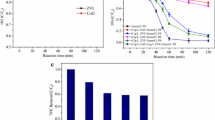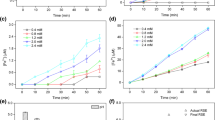Abstract
Zero-valent iron (Fe0), as an alternative iron source, was evaluated to activate persulfate (PS) to degrade acetaminophen (APAP), a representative pharmaceutically active compound in water. Effects of key factors in the so-called Fe0/PS process, including Fe0 dosage, initial pH, temperatures and chelating agents, were studied. Under all the conditions tested, the APAP degradation followed a pseudo-first-order kinetics pattern. The degradation efficiency of APAP was highest when the Fe0 to PS molar ratio increased to 1:1, and the degradation rate constant and removal were 23.19 × 10−3 min−1 and 93.19 %, respectively. Comparing with Fe2+, Fe0 served as an alternative iron source that can gradually release Fe2+ into water, thereby consistently activating PS to produce sulfate radicals. The Fe0/PS system was effective in a broader pH range from 3 to 8.5. Heat could facilitate production of sulfate radicals and enhance the APAP degradation in the Fe0/PS system. High reaction temperature also improved the Fe2+/PS oxidation of APAP. Finally, sodium citrate (a chelating agent) at an appropriate concentration could improve the APAP degradation rate in the Fe2+/PS and Fe0/PS system. The optimal molar ratio of Fe0 to citrate depended on solution pH. Our results demonstrated that Fe0 was an alternative iron source to activate PS to degrade APAP in water.








Similar content being viewed by others
References
Anipsitakis GP, Dionysiou DD (2003) Degradation of organic contaminants in water with sulfate radicals generated by the conjunction of peroxymonosulfate with cobalt. Environ Sci Technol 37(20):4790–4797
Anipsitakis GP, Dionysiou DD (2004) Radical generation by the interaction of transition metals with common oxidants. Environ Sci Technol 38(13):3705–3712
Anoniou MG, De La Cruz AA, Dionysiou DD (2010) Degradation of microcystin-LR using sulfate radicals generated through photolysis, thermolysis and e− transfer mechanisms. Appl Catal B Environ 96(3–4):290–298
Antoniou MG, De La Cruz AA, Dionysiou DD (2010) Intermediates and reaction pathways from the degradation of microcystin-LR with sulfate radicals. Environ Sci Technol 44(19):7238–7244
Buxton GV, Bydder M, Salmon GA (1999) The reactivity of chlorine atoms in aqueous solution. Part II. The equilibrium SO ·−4 + Cl− reversible arrow Cl· + SO4 2−. Phys Chem Chem Phys 1(2):269–273
Cao JS et al (2008) Oxidation of lindane with Fe(II)-activated sodium persulfate. Environ Eng Sci 25(2):221–228
Choi KH, Lee WJ (2012) Enhanced degradation of trichloroethylene in nano-scale zero-valent iron Fenton system with Cu(II). J Hazard Mater 211–212(15):146–153
Criquet J, Vel Leitner NK (2009) Degradation of acetic acid with sulfate radical generated by persulfate ions photolysis. Chemosphere 77(2):194–200
Gayathri P, Dorathi RPJ, Palanivelu K (2010) Sonochemical degradation of textile dyes in aqueous solution using sulphate radicals activated by immobilized cobalt ions. Ultrason Sonochem 17(3):566–571
Ghauch A, Tuqan AM (2012) Oxidation of bisoprolol in heated persulfate/H2O system: kinetics and products. Chem Eng J 183(15):162–171
Guan YH et al (2011) Influence of pH on the formation of sulfate and hydroxyl radicals in the UV/peroxymonosulfate system. Environ Sci Technol 45(21):9308–9314
Hussain I et al (2012) Degradation of p-chloroaniline by persulfate activated with zero-valent iron. Chem Eng J 203:269–276
Johnson RL, Tratnyek PG, Johnson RO (2008) Persulfate persistence under thermal activation conditions. Environ Sci Technol 42(24):9350–9356
Li Y, Bachas LG, Bhattacharyya D (2005) Kinetic studies of trichlorophenol destruction by chelate-based Fenton reaction. Envion Eng Sci 22(6):756–771
Liang CJ et al (2004a) Persulfate oxidation for in situ remediation of TCE. I. Activated by ferrous ion with and without a persulfate-thiosulfate redox couple. Chemosphere 55(9):1213–1223
Liang CJ et al (2004b) Persulfate oxidation for in situ remediation of TCE. II. Activated by chelated ferrous ion. Chemosphere 55(9):1225–1233
Liang CJ et al (2007a) Hydroxypropyl-β-cyclodext-rin-mediated iron-activated persulfate oxidation of trichloroethylene and tetrachloroethylene. Ind Eng Chem Res 46:6466–6479
Liang CJ, Wang ZS, Bruell CJ (2007b) Influence of pH on persulfate oxidation of TCE at ambient temperatures. Chemosphere 66(1):106–113
Lin AY et al (2010) Potential for biodegradation and sorption of acetaminophen, caffeine, propranolol and acebutolol in lab-scale aqueous environments. J Hazard Mater 183(1–3):242–250
Lucking F et al (1998) Iron powder and graphite and activated carbon as catalyst for the oxidation of 4-chlorophenol with hydrogen peroxide in aqueous solution. Water Res 32(9):2607–2614
Matta R et al (2011) Removal of carbamazepine from urban wastewater by sulfate radical oxidation. Environ Chem Lett 9(3):347–353
Mora VC et al (2009) Thermally activated peroxydisulfate in the presence of additives: a clean method for the degradation of pollutants. Chemosphere 75(10):1405–1409
Neppolian B, Doronila A, Ashokkumar M (2010) Sonochemical oxidation of arsenic(III) to arsenic(V) using potassium peroxydisulfate as an oxidizing agent. Water Res 44(12):3687–3695
Nfodzo P, Choi H (2011) Triclosan decomposition by sulfate radicals: effects of oxidant and metal doses. Chem Eng J 174(2–3):629–634
Oh SY et al (2009) Oxidation of polyvinyl alcohol by persulfate activated with heat, Fe2+, and zero-valent iron. J Hazard Mater 168(1):346–351
Oh SK, Kang SG, Chiu PC (2010) Degradation of 2.4-dinitrotoluene by persulfate activated with zero-valent iron. Sci Total Environ 408(16):2464–3468
Rastogi A, Al-Abed SR, Dionysiou DD (2009a) Effect of inorganic, synthetic and naturally occurring chelating agents on Fe(II) mediated advanced oxidation of chlorophenols. Water Res 43(3):684–694
Rastogi A, Al-Abed SR, Dionysiou DD (2009b) Sulfate radical-based ferrous-peroxymonosulfate oxidative system for PCBs degradation in aqueous and sediment systems. Appl Catal B Environ 85(3–4):171–179
Romero A et al (2010) Diuron anatement using acitvated persulfate: effect of pH, Fe(II) and oxidant dosage. Chem Eng J 162(1):257–265
Sun JH et al (2009) Oxone/Co2+ oxidation as an advanced oxidation process: comparison with traditional Fenton oxidation for treatment of landfill leachate. Water Res 43(17):4363–4369
Tan CQ et al (2012a) Degradation of diuron by persulfate activated with ferrous ion. Sep Purif Technol 95(19):44–48
Tan CQ et al (2012b) Heat-activated persulfate oxidation of diuron in water. Chem Eng J 203(1):294–300
Verma PS, Saxena RC, Jayaraman A (1997) Cyclic voltammetric studies of certain industrially potential iron chelate catalysts. Fresenius’ J Anal Chem 357(1):56–60
Waldemer RH, Tratnyek PG, Johnson RL, Nurmi JT (2007) Oxidation of chlorinated ethenes by heat-activated persulfate: kinetics and products. Environ Sci Technol 41(3):1010–1015
Xu XR, Li XZ (2010) Degradation of azo dye Organge G in aqueous solutions by persulfate with ferrous ion. Sep Purif Technol 72:105–111
Zhang X et al (2008) Photodegradation of acetaminophen in TiO2 suspended solution. J Hazard Mater 157(2–3):300–307
Zhao JY et al (2010) Enhanced oxidation of 4-chlorophenol using sulfate radicals generated from zero-valent iron and peroxydisulfate at ambient temperature. Sep Purif Technol 71(3):302–307
Zhou T et al (2008) Oxidation of 4-chlorophenol in a heterogeneous zero valent iron/H2O2 Fenton-like system: kinetic, pathway and effect factors. Sep Purif Technol 62(3):551–558
Acknowledgments
Financial supports from the National Major Project of Science and Technology Ministry of China (2008ZX07421-002) and the research and development Project of Ministry of Housing and Urban–Rural Development (2009-K7-4). We are also thankful to the reviewers for their valuable advice to improve this manuscript.
Author information
Authors and Affiliations
Corresponding author
Rights and permissions
About this article
Cite this article
Deng, J., Shao, Y., Gao, N. et al. Zero-valent iron/persulfate(Fe0/PS) oxidation acetaminophen in water. Int. J. Environ. Sci. Technol. 11, 881–890 (2014). https://doi.org/10.1007/s13762-013-0284-2
Received:
Revised:
Accepted:
Published:
Issue Date:
DOI: https://doi.org/10.1007/s13762-013-0284-2




